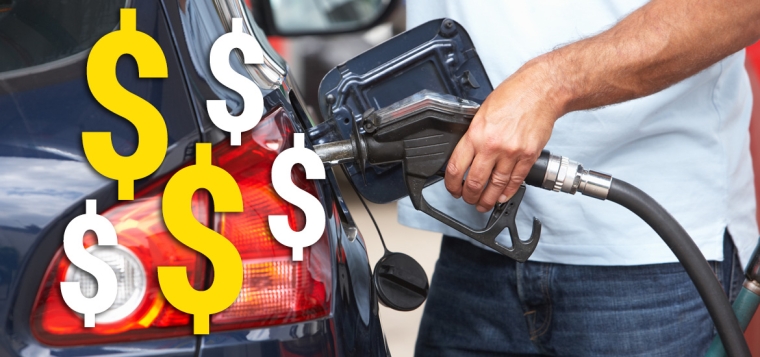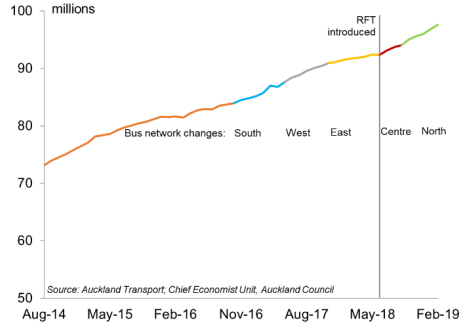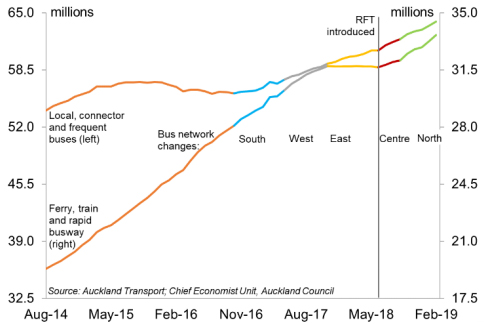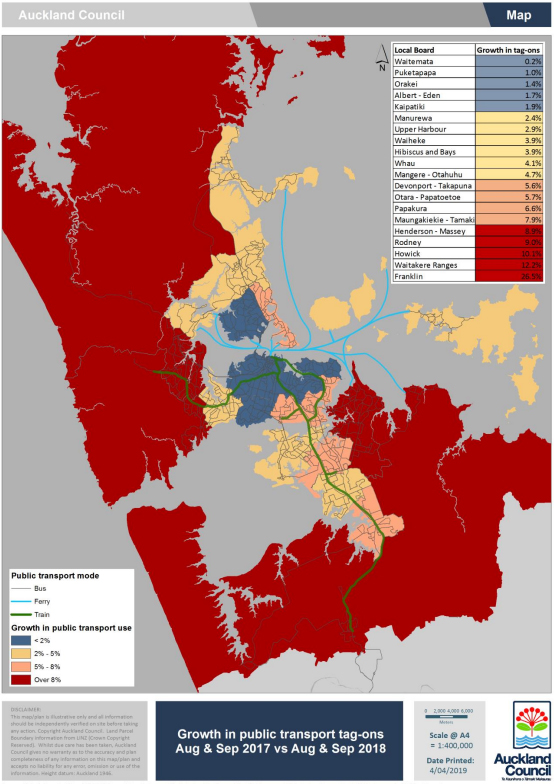
• There has been an uptick in growth in public transport (PT) use since July 2018.
• Two significant events affected demand for PT in July – a change to the bus network, and the introduction of the Regional Fuel Tax (RFT).
• Growth in public transport in August and September 2018, compared with the same period a year earlier, suggests the strongest growth has been in the more distant reaches of the city, exactly where you would expect it to be highest given the impact of the RFT on the attractiveness of driving.
• While the RFT was introduced primarily to fund much-needed transport improvements, stimulating PT uptake is one of its key sidebenefits, and one it is already delivering upon.
PT patronage in Auckland has been growing for years, but at a sharper rate since July 2018. In fact, in the eight months since the end of June, annual patronage in Auckland is up 8.9% compared to the same eight months a year earlier.
This growth rate is twice what we saw in the 12 months to June 2018, and 33% higher than growth in the year to June 2017, a period during which several bus network changes were implemented.
Annual PT patronage and bus network changes, Auckland

Annual PT patronage by mode and bus network changes, Auckland

Whereas growth over the previous years has often been driven by modes other than regular local buses – trains and the rapid busway mostly – the recent surge has been widespread across PT modes.
Who’s driving this bus?
So why has there been the sudden acceleration in an-already solid growth rate of PT use?
The relationship between PT use, petrol prices, population growth, personal preferences and PT networks is complex. Still, there are two obvious culprits for the uptick commencing in July 2018. From 1 July 2018, the RFT came into effect in Auckland, raising petrol prices. And on 8 July, the new central Auckland bus network came into effect, changing routes and frequencies throughout the isthmus area from New Lynn to Panmure.
We examined AT HOP card tag-on data for the months of August and September 2018, comparing them to the same period the year before.1 We found that in the six Local Boards that make up the isthmus, total PT tag-ons (excluding transfers) across all PT types increased 1.6%, and 2% on buses, presumably aided by the new bus network. Meanwhile, in the rest of Auckland, tag-ons were up 5.8% in total, and 6.4% on buses.
If PT use had changed at the same 1.6% rate outside the isthmus as it changed on the isthmus, we’d have seen almost 3,600 fewer PT tag-ons a day than we actually saw in the rest of Auckland.
In other words, while the change in the central city network seems to have played a role in the latest surge in tag-ons, it is the more distant parts of the city, which didn’t receive a network change in this time, that saw a bigger change in tag-ons. These parts of the city have longer travel distances to get to the city for work, for instance. Growth in tag-ons in August to September 2018 compared to a year earlier was 27% in Franklin, 12% in the Waitakere Ranges, 10% in Howick, and 9% in both Rodney and Henderson-Massey. The map at the end of this paper shows the clear pattern by Local Board.
The RFT appears to have played a significant role in changing people’s behaviour over and above network changes, by encouraging them to use PT rather than their cars.
Petrol prices peaked in October 2018, and have since fallen, yet the change in behaviour has stuck, no doubt aided by the new bus network for the North Shore that begin on 30 September 2018.
But wait, there’s more
At the time the RFT was being introduced, the Chief Economist Unit identified seven advantages the RFT provided. Stimulating a switch to PT to help decongest our roads was just one of those.
Naturally, the main benefit was an immediate shot in the arm to funding much-needed transport infrastructure projects in Auckland. One major such project is the Eastern Busway, which is underway, and which the RFT will help fund through Stages 2 to 4. But the RFT would likely also:
• reduce the discretionary vehicle kilometres travelled in Auckland, again reducing congestion and emissions
• broadly align with the beneficiary pays principle – those who use the roads more would generally contribute more toward funding
• incentivise people to switch to more fuelefficient cars, reducing emissions
• be easily administered (the economic principle of administrative efficiency)
• be hard to avoid, as less than 4% of Auckland’s population lives close to regional boundaries.
Not perfect, but right for now
Of course, there are limitations to the RFT. Not everyone can afford to buy a more fuel efficient car. Access to frequent PT alternatives is not universal, although the RFT itself will play a big part in increasing access. Some would say that the RFT is only a stop-gap on the way to a more comprehensive traffic demand management system such as congestion pricing.
But right now, the RFT is already paying dividends in helping change how people travel, doing its bit to free up space on the roads.

*David Norman is chief economist at the Auckland Council. This article was first published here.
13 Comments
Yes, dear comrades, you may now travel by bus. Only bourgeois capitalists can afford to drive a car.
Is it just me, or does this piece sound like a bit of propaganda for the twenty third five year plan of the Central Planning Committee?
People like their cars and the freedom they provide to go where you want, when you want. This is now be taken away, all in the name of progress, of course. Are we just getting poorer?
Buses are great. Unless it is raining and you don't live next to a bus stop, or you are elderly, or you have plenty of shopping, or you have several children, or you are going requires one or two changes of bus, or you need to break a journey to stop for shoppng or tood take-away or library, or you are nervous and travelling in the evening. Otherwise great. Be better if accompanied children were free.
It's a nice piece of puffery - 'Look how Wise we are and how Well we have done already'.
But propelling people onto PT (if that indeed can be sheeted home to the RFT and not to other price movements, the phase of the moon, and countless other moving parts) is by no means an unalloyed Joy:
- it turns free agents into commuters, with exposure to the vagaries of PT unions, timetables, frequency and general reliability.
- if indeed the RFT is a driver, it hits the lowest SES hardest - a thoroughly regressive tax.
The Mk I Eye-o-meter tells me that the general slope of the grpahs of patronage is in fact reverting to a mean, and that means, giving the Mk I Brain cells a leetle work-out. just keeping pace with population growth.
Oh, for some solid economics, like pax-km per capita. But no, its RE-style spruikery all the way to the next rate-payer-funded payday.
Meanwhile, the RFT taxes you regardless of whether you have no access to rapid transit or live within walking distance to the North Shore busway.
It taxes you no matter what time you travel or if you manage to move your hours of work to avoid peak congestion.
It taxes you even if there's six thousand new houses going in your area with single lane roads and no fixed dates for rapid transit in your area; as such, it taxes you for additional congestion that is actively induced by Council policy.
Likewise, it punishes those who are commuting from suburbs further out that intensify and clog networks at the expense of inner city areas with access to gold-plated PT that have 'character' or 'heritage' protection and further development is essentially prohibited.
It taxes you even if you use the fuel on the motorway, which is NZTA's remit, not ATs.
It then takes that money, and gives a gold plated subsidy for a taxi service to a select few residents in a well-off area like Devonport, where there is relatively little intensification planned, while the residents of West and North West Auckland are stuck idling in traffic, using more fuel, emitting more carbon dioxide and yet are still expected to accommodate a higher portion of the city's growth.
In that sense it is less a 'fuel tax' and more a 'planning failure levy' borne by the people who are most affected by it. And that's before you consider the cost of time spent in traffic; and the impact on lifestyles, families and mental health that radiates disproportionately outwards to those who can least afford it.
As a blunt tool, yes, it's fantastic. But it is so massively inequitable that you cannot ignore its pitfalls; and while I appreciate NZTA has the Council somewhat in a corner over major projects, we're still paying the fuel tax either way.
He simplistically attributes the increased PT uptake to the tax.
However, the price of petrol was high and rising regardless of the tax, so the trend was on its way anyway. Sure, the tax would have pushed it a long a bit further.
I'm a bit sick of this self-congratulatory propaganda.
Investing in buses and trains is betting that giants like GM, Ford, Google and the Chinese government wont get driverless transport working. Not a bet that I would make.
The incredible low cost and convenience that things like electric driverless cabs will offer will be the end of conventional public transport modes. A typical ride to work will cost about $2 and wont need subsidies.
A much better solution than the nonsense in this article would be to increase road capacity in preparation for the sea change that's certainly coming.
At $2 a ride I wonder who would be paying to build and maintain roads? That would probably be less than the current petrol tax paid for an average car trip.
Also if it is only private companies using roads, shouldn't the government expect to make a return on that investment? I wonder how much they would need to charge to get a decent return on all those roads and land?
...and I awake this morning to see that now Twyford is softening us up for no Light Rail to the North West at all.
There's still thousands of new houses going in up the road though. So where can the people of NW who were sold a pup at the last election get a refund of their fuel taxes, now that we're the city's development whipping boys?
I've totally given up on the Minister. This current government is making the last government look competent.
I credit them with the much needed Foreign Buyer Ban, but apart from that they've been really poor (although Jacinda has been a good Statesperson, even if I am not convinced on her leadership behind the facade).
I know someone who went to the planning institute conference last week, apparently David Parker spoke and he was poor - poorly prepared, poorly presented, with nothing new to say

We welcome your comments below. If you are not already registered, please register to comment.
Remember we welcome robust, respectful and insightful debate. We don't welcome abusive or defamatory comments and will de-register those repeatedly making such comments. Our current comment policy is here.